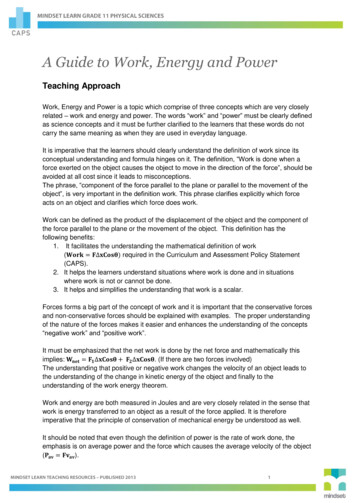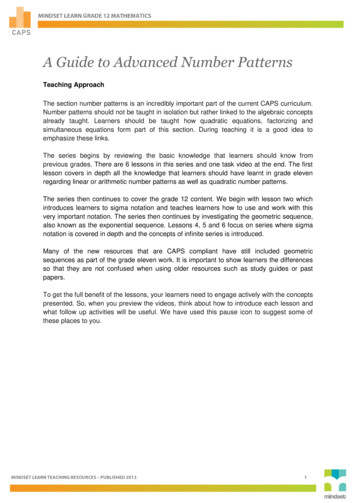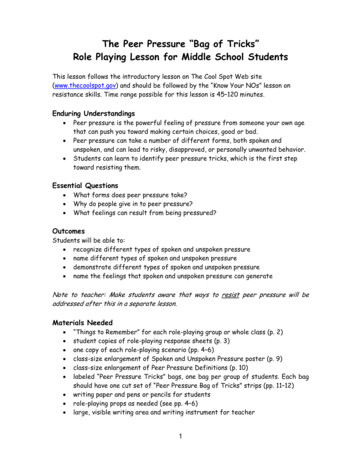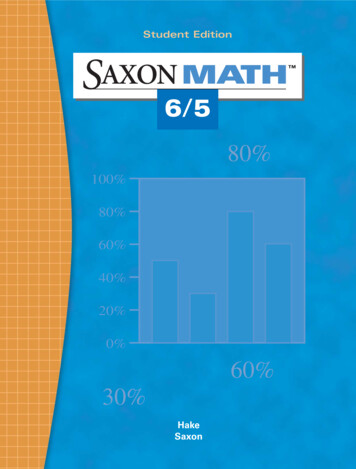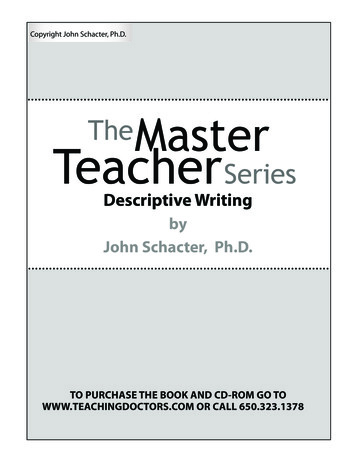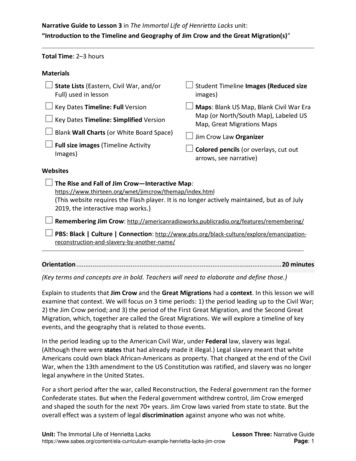
Transcription
Narrative Guide to Lesson 3 in The Immortal Life of Henrietta Lacks unit:“Introduction to the Timeline and Geography of Jim Crow and the Great Migration(s)”Total Time: 2–3 hoursMaterials State Lists (Eastern, Civil War, and/or Student Timeline Images (Reduced sizeFull) used in lessonimages) Key Dates Timeline: Full Version Maps: Blank US Map, Blank Civil War EraMap (or North/South Map), Labeled US Key Dates Timeline: Simplified VersionMap, Great Migrations Maps Blank Wall Charts (or White Board Space) Jim Crow Law Organizer Full size images (Timeline Activity Colored pencils (or overlays, cut outImages)arrows, see narrative)Websites The Rise and Fall of Jim Crow—Interactive ndex.html(This website requires the Flash player. It is no longer actively maintained, but as of July2019, the interactive map works.) Remembering Jim Crow: /remembering/ PBS: Black Culture Connection: ntation . 20 minutes(Key terms and concepts are in bold. Teachers will need to elaborate and define those.)Explain to students that Jim Crow and the Great Migrations had a context. In this lesson we willexamine that context. We will focus on 3 time periods: 1) the period leading up to the Civil War;2) the Jim Crow period; and 3) the period of the First Great Migration, and the Second GreatMigration, which, together are called the Great Migrations. We will explore a timeline of keyevents, and the geography that is related to those events.In the period leading up to the American Civil War, under Federal law, slavery was legal.(Although there were states that had already made it illegal.) Legal slavery meant that whiteAmericans could own black African-Americans as property. That changed at the end of the CivilWar, when the 13th amendment to the US Constitution was ratified, and slavery was no longerlegal anywhere in the United States.For a short period after the war, called Reconstruction, the Federal government ran the formerConfederate states. But when the Federal government withdrew control, Jim Crow emergedand shaped the south for the next 70 years. Jim Crow laws varied from state to state. But theoverall effect was a system of legal discrimination against anyone who was not white.Unit: The Immortal Life of Henrietta example-henrietta-lacks-jim-crowLesson Three: Narrative GuidePage: 1
Narrative Guide to Lesson 3 in The Immortal Life of Henrietta Lacks unit:“Introduction to the Timeline and Geography of Jim Crow and the Great Migration(s)”This same period included years of enormous change in America. During the late 1800’s andcontinuing through the 1900’s, America experienced the introduction of cars (1900’s),electrification of homes (1880-1950), powered farm and factory machinery (1890’s), telephones(1890’s), Women’s Suffrage (1920) and many, many other changes.Also in the 1900’s, two World Wars and other economic factors created major changes to thetypes of jobs that needed to be filled, and where those jobs were located.Against this backdrop of Jim Crow, industrialization and other changes, millions of Blacks movedfrom the rural South to the urban North in two separate waves in what is called the GreatMigrations.ACTIONGeography/Events Pre-Assessment Activity . 20 minutesIntroduction:When we talk about the United States, we often make statements about geographic regions:the North, the Northeast, the South, the West, the mid-West, the Deep South. Here are someexamples of those terms in use:“The South “Patterns of death in the South stillwill riseshow the outlines of ortalagain.”ity-black-belt/)“Forbidding Forecast for Lyme Diseasein me-disease-in-the-northeast)In studying Jim Crow and the Great Migrations, it is helpful to use labels like “The North” and“The South”. In this lesson we will learn what those labels mean. To begin, we’re going to seewhat you already know about those regions.Give students the state list and a map.1. Ask them to identify as many of the states as they can on the map. (The state listprovided is the states at the end of the Civil War. A variation of that is to provide ashorter list of states and a map of only the Eastern U.S.) Students may work alone or ingroups. Students may be able to identify only a handful of states.2. When they have done as much as they can, provide a map of the United States, andhelp students make corrections and add the rest of the states. Give the context of themap you chose to use for this exercise (i.e. only the eastern US, the states at the time ofthe Civil War, the states as of 1950, etc.)Unit: The Immortal Life of Henrietta example-henrietta-lacks-jim-crowLesson Three: Narrative GuidePage: 2
Narrative Guide to Lesson 3 in The Immortal Life of Henrietta Lacks unit:“Introduction to the Timeline and Geography of Jim Crow and the Great Migration(s)”Tell students that during the Civil War, the Union was northern states, or “The North”. TheConfederacy was southern states, or “The South”. (Review cardinal directions if necessary.)3. Ask students to indicate where on the map they think the divide was between the North(The Union) and the South (The Confederacy).4. Then show them where it actually was, and have them add it to their maps along withthe appropriate labels. They may also want to (lightly) color in the North and the Southusing different colors.Attaching Images to Events on a Timeline . 30 minutesPost a timeline (on a whiteboard, on the wall, on a clothesline etc.), and use it to explicitly teacha short overview of the following periods/events: Great Migrations: Southern blacks Legal Slavery in U.S.: (mostly, but notmoving to the North to flee oppressionexclusively, in the South) 1600-1865(hangings/KKK violence) and to findbetter paying jobs/more opportunities. The Emancipation Proclamation: freeso First Great Migration, 1910-1940;the slaves in Confederate States, 1862o Second Great Migration, 1940 American Civil War, 1861-18651970. Reconstruction: The Federalgovernment runs the formerConfederate States. Southern Blackswere free to own land. Black men couldvote and run for office. Blacks couldstart schools, and participate incommerce. 1865-1877.Jim Crow: Laws and systems created byWhite Southern legislators to subvertthe changes that had begun underReconstruction and discriminate againstblacks, 1877-1950. World Wars:o WW I, 1914-1918.o WW II, 1939-1945. Civil Rights Movement: protests againstdiscrimination took place in the Northand the South. Many northern blacksand whites went into the South to fightfor civil rights. 1950’s through 1960’s.Put students into groups and give each group of students one or more images (see resources:Timeline Activity Images).1. Their task is to match images to the timeline periods and attach to the posted timeline.2. Discuss and adjust as necessary so that the images are matched to the appropriate timeperiod.3. Give students the simplified, blank version of the timeline and the images reduced to theappropriate size, and have them assemble an illustrated timeline of their own.Unit: The Immortal Life of Henrietta example-henrietta-lacks-jim-crowLesson Three: Narrative GuidePage: 3
Narrative Guide to Lesson 3 in The Immortal Life of Henrietta Lacks unit:“Introduction to the Timeline and Geography of Jim Crow and the Great Migration(s)”Introduce the Key Dates Timeline . 20 minutes1. Ask students to identify the 5 major time periods (color-coded below) the horizontal line onthe map. They should identify the Triangle Trade, Legal Slavery, Reconstruction, Jim Crow,and the Great Migrations.2. Ask students to put them in order by length of time.The list (from longest to shortest) should read:(1) Triangle Trade (approximately 300 years)(2) Legal Slavery (approximately 250 years)(3) Jim Crow (approximately 75 years)(4) The Great Migrations (approximately 40 years)(5) Reconstruction (approximately 12 years)3. Guide a discussion about the differences betweenthe periods. One key understanding from thatdiscussion should be that the length of time ofReconstruction when there was any widespreadimprovement to African-American is extremelyshort compared to the other periods on thetimeline.4. In a brief overview, offer a description/explanationof each item/event on the timeline. If possible,focus on an African-American framework/perspective for each item.If there is a question about thedifference between Legal Slaveryand The Triangle Trade on thetimeline, the general answer isthat after 1807 it was illegal toimport slaves into the UnitedStates. The only way for an ownerto expand the number of slaves heowned was to buy existing slaves,or through ‘breeding’ of existingslaves.If there are questions about whylegal slavery doesn’t extend backbefore 1600, the general answer isthat this was approximately whenthe early settlements began tolegislate about the issue of slavery.Geography of Jim Crow and the Great Migrations . 45 minutesDo a brief review the geography from the Civil War/North-South map from the beginning of thelesson.1. Ask students to return to this link: http://www.pbs.org/wnet/jimcrow/themap/map.htmland use it to fill out the Jim Crow Law Organizer (which states had Jim Crow laws). Thisactivity works well with pairs or groups of students, one using the organizer and one usingthe map.2. Give students a blank map of the US.a. Have them label the map: Jim Crow and The Great Migrations.b. Using their Jim Crow Law Organizer have them write the initial “E” on each state thathad Education laws.c. Have them write “H & P” on each state that had Hospital and Prison laws.Unit: The Immortal Life of Henrietta example-henrietta-lacks-jim-crowLesson Three: Narrative GuidePage: 4
Narrative Guide to Lesson 3 in The Immortal Life of Henrietta Lacks unit:“Introduction to the Timeline and Geography of Jim Crow and the Great Migration(s)”d. Continue this pattern using “M” for Miscegenation Laws, “PA” for PublicAccommodations, and “O” for Other.e. Then have students lightly color in the states that were part of the Confederacy duringthe Civil War.3. Lead a discussion of the patterns that emerge. Two key understandings could include that:(1) The majority of initials are on the former Confederate states; and(2) Jim Crow was not “just a southern institution.”4. Show students maps of the routes for the Great Migrations. Have students overlay arrowsfor these routes on their maps. (Use colored pencils, arrows cut from paper, or arrowsdrawn on transparencies, or something similar.)CLOSURE .5 minutes or lessHave students add Great Migration information—State You Move To (page 3)—to theirCharacter Template for the final project.Enhancements/ExtensionsThere is room in this lesson for social historical research and/or teaching on topics likeindustrialization, Women’s Suffrage, reconstruction, miscegenation, etc.Unit: The Immortal Life of Henrietta example-henrietta-lacks-jim-crowLesson Three: Narrative GuidePage: 5
Narrative Guide to Lesson 3 in The Immortal Life of Henrietta Lacks unit: “ Introduction to the Timeline and Geography of Jim Crow and the Great Migration(s) ” Unit: The Immortal Life





